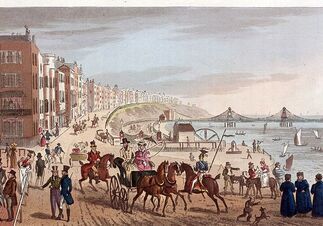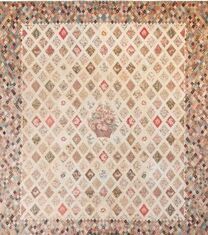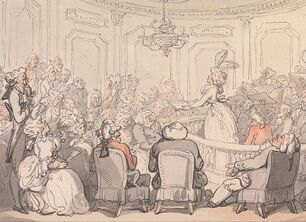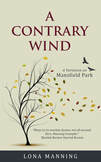CMP#233 Mary, the Fanny-like heroine
 “Though I am mute, I am not always unobserving.” “it had even the power of partly raising Lady Lauretta from her recumbent attitude, who had almost given it her attention.”“Mary, who always felt too insignificant in her own estimation, to take umbrage at any rudeness which was offered to her, very readily agreed to be of the party.” -- Some quotes from Substance and Shadow for the delectation of Mansfield Park fans.
“Though I am mute, I am not always unobserving.” “it had even the power of partly raising Lady Lauretta from her recumbent attitude, who had almost given it her attention.”“Mary, who always felt too insignificant in her own estimation, to take umbrage at any rudeness which was offered to her, very readily agreed to be of the party.” -- Some quotes from Substance and Shadow for the delectation of Mansfield Park fans.Substance and Shadow, or, the Fisherman’s Daughters of Brighton, a Patchwork story in four volumes by the author of Light and Shade, Eversfield Abbey, Banks of the Wye, Aunt and Niece, etc. etc. Minerva Press, 1812. CMP#233 Substance and Shadow, a forgotten novel with a lot of Austen parallels
 Brighton, T. Cruickshank (detail) 1824 Substance and Shadow opens with a genteel lady watching a storm blow in to the shore at Brighton, then a fashionable watering place patronized by the Prince of Wales. Mrs. Elwyn is amused by the rhapsodies of another young lady gamboling along on the beach, exclaiming over the tremendous crashing of the waves. We have here the same dichotomy Jane Austen used in Sense and Sensibility. Clara Elwyn “knew that romance and enthusiasm were the leading features of the day, and that those feelings were nurtured and indulged, at the hazard of running counter to all the forms and usages of society, and the good old way in which she had been taught to walk.”
Brighton, T. Cruickshank (detail) 1824 Substance and Shadow opens with a genteel lady watching a storm blow in to the shore at Brighton, then a fashionable watering place patronized by the Prince of Wales. Mrs. Elwyn is amused by the rhapsodies of another young lady gamboling along on the beach, exclaiming over the tremendous crashing of the waves. We have here the same dichotomy Jane Austen used in Sense and Sensibility. Clara Elwyn “knew that romance and enthusiasm were the leading features of the day, and that those feelings were nurtured and indulged, at the hazard of running counter to all the forms and usages of society, and the good old way in which she had been taught to walk.”But Mrs. Elwyn is concerned because she knows that a fisherman and his wife had gone out to sea that morning, and have not returned. The following morning brings the sad news that they are drowned, and Mrs. Elwyn benevolently visits the humble cottage where their twin infant daughters are being cared for by a neighbor woman. The babies will now become the responsibility of the parish and their prospects are bleak. Suddenly, the excitable young lady, also drawn to the news of the catastrophe, swoops in and carries off one of the babies. Mrs. Elwyn decides to give a home to the other. It will give her someone to care for, since she is childless and her husband is polite but remote and often absent... An experiment in education
So, we have the situation of twin girls separated almost at birth, and raised in completely different ways. This is yet another novel which stresses the importance of upbringing and education in the formation of character, and hence, one’s destiny in life.
When Mrs. Elwyn asks for her husband’s permission to foster little Mary in their home, he responds with: what a coincidence! He wants to introduce a little boy into the household, who is the…. uh…. the orphaned son of a good friend whom he had never happened to mention before. His name is Henry.
Mrs. Elwyn raises Mary while Henry spends most of his time at boarding school and university and Mr. Elwyn sinks into stupid lethargy. She aims to make little Mary into a “reasonable and rational being” so “rational and reasonable ideas must be implanted in her mind.” But don't be misled by the use of "rational" to suppose that Mrs. Elwyn is a disciple of Mary Wollstonecraft. Quite the opposite. This is definitely a conservative novel that praises virtue, modesty and forbearance. The authoress makes her intention very clear: “our design is to shew the practical advantages of a judicious education, and the stability and strength of mind which may be derived from an early knowledge of religion, and an exercise of its duties, even by a weak and timid female.."
Mary grows up to be intelligent and clever like Fanny Price in Mansfield Park, but she hides her light under a bushel, because of the “modesty of her disposition.” As a girl from a humble background elevated into a genteel household, Mary also has Fanny Price's socially ambiguous status.
 Patchwork coverlet made by Jane Austen, her mother and Cassandra Secrets come to light
Patchwork coverlet made by Jane Austen, her mother and Cassandra Secrets come to lightMrs. Elwyn dies, leaving four thousand pounds for Mary to inherit when she comes of age or marries. Mary will not be forced into getting a job, but she is stuck with living with Mr. Elwyn and a new foster-stepmother. For, after Mrs. Elwyn is buried, Mr. Elwyn’s guilty secret comes out--he confesses that he was already married when married Clara! In his youth, he secretly married the pretty sister of a school chum. The school chum died, so there was no-one to stand up for the poor girl when he lied to her and told her their marriage was invalid, due to their being underage. He married his cousin Clara for the secure family money, and parked his first wife Ellen in a cottage. They had a son. So Clara Elwyn went to her grave without knowing that her loveless, childless marriage was also bigamous and Mr. Elwyn got away with it. Henry and Clara try to adjust to this awkward new situation. On the plus side for Henry, he's acknowledged as Mr. Elwyn's legitimate son and heir.
Mr. Elwyn brings his long-neglected first wife into the mansion. Her youthful charms have fled, she is merely an underbred, uneducated woman who lives for gossip and making patchwork quilts, an occupation that for some reason, the authoress scorns.
The neighborhood is also enlivened by the arrival of a couple recently returned from India: General Maxwell and his much older wife. They have houseguests too, Lady Lauretta and her daughter Lauretta Montgomery. This young lady bears an uncanny resemblance to Mary, except that Mary dresses simply and soberly and Lauretta is decked out and groomed to the nines. Incidentally, the Maxwells, Lady Lauretta, and her daughter have all just returned from the East Indies--yet another example of how authors of the time used the Indies, East and West, to keep their characters off-stage when their absence is needed for plot purposes (cough Sir Thomas cough).
 Thomas Rowlandson, "Comforts of Bath" Mansfield Park-isms
Thomas Rowlandson, "Comforts of Bath" Mansfield Park-ismsOur mild-tempered heroine just can’t approve of Lauretta Montgomery and her flirtatious ways, but Henry is besotted with her. Mary can’t understand how Henry is “blind” to the faults of both mother and daughter: “‘His perception, his discernment, are usually not defective; is it possible that he cannot see it? Or is it possible that I see it through a prejudiced medium?' and then would she take herself to task, and try to discover whether to malice, envy, or uncharitableness, she could impute her opinions on this subject.”
At least Mary, unlike Fanny, has the advantage of an impartial bystander who sees things as she does—the blunt but kindly old neighbour Mr. Munsden.
Mr. Elwyn suddenly dies, and the widow Elwyn, the addle-pated Ellen, soon marries one of her male servants. To escape this trying situation, Mary goes to live with Mr. Munsden’s widowed sister in Bath. While there, she goes to a musical concert and encounters Henry busily courting Lauretta, and also Henry’s friend Frederic Fitzallen, who is quite taken with her.
 Rev. Thomas Secker (1693 –1768) by Reynolds Spoiler wrap up
Rev. Thomas Secker (1693 –1768) by Reynolds Spoiler wrap upFrom here, chickens come home to roost for all the characters. Henry impulsively marries Lauretta and belatedly discovers what a selfish, immature character she is. He had started this novel in the pole position for being the hero, but by volume IV he is a miserable gambler, throwing away the family fortune at the card table. Lauretta’s mother is jilted at the altar, Henry's mother is miserable in her marriage to the servant, while Mary has enough money to take a nice cottage with her friend Miss Letsom. The young ladies are quite content in their new life and I think the authoress promotes the desirability of a quiet life of self-sufficiency--but on the other hand, this is a four -volume novel so the heroine should get a marriage by the end of it. And she does, to Mr. Fitzallan, now Sir Frederic on the death of his father.
The authoress finishes off by quoting Thomas Secker, the Archbishop of Canterbury: “Length of days, easy circumstances, general esteem, domestic tranquility, national good order and strength, are the smaller advantages that usually attend practising the rules of religion; but the constant ones, the calm peace, and joyful prospects, of all whose minds are duly affected by the genuine principles of it, these are blessings inexpressibly great.”
Heroine Mary is a sympathetic character despite being a heroine in the gentle, forbearing Fanny Price mode. She is free of Fanny’s tendency to passive-aggressiveness. She acts quickly when Lauretta's muslin gown catches fire, grabbing a shawl to smother the flames--what would Fanny have done in the same situation?
Substance and Shadow did not receive any reviews when it was published, but I found it to be fairly engaging and it kept me guessing whether Mary would end up with Henry or Frederic. The authoress makes good use of all her characters in her plots and subplots. The hero is introduced late into the story but he is the one who takes the initiative of visiting Brighton to confirm that Lauretta and Mary are sisters and of legitimate birth. This is to counteract a malicious rumor that the late Mrs. Elwyn had an illegitimate child and lied about Mary being a fisherman’s daughter.
I also expected to learn that somehow or other, Mary and Lauretta weren't the humble offspring of a fisherman and his wife. That their mother was perhaps of genteel birth or something--because usually foundling heroines turn out to be well-born, a notion that upholds heredity over upbringing, or nature over nurture. This author gives us a heroine who is actually a fisherman's daughter who marries a baronet. And he's happy to marry her because he recognizes her worth as a person.
About another six novels to go before I’ve read through all the novels involved in the attribution chain of The Woman of Colour. Previous post: An old review of Mansfield Park
 Not everybody who reads Mansfield Park is happy with Fanny Price marrying her cousin Edmund. I had to contend with this question myself as the plot for my Mansfield Trilogy unfolded. For more about my novels, click here.
Not everybody who reads Mansfield Park is happy with Fanny Price marrying her cousin Edmund. I had to contend with this question myself as the plot for my Mansfield Trilogy unfolded. For more about my novels, click here.
Published on November 06, 2025 00:00
No comments have been added yet.



